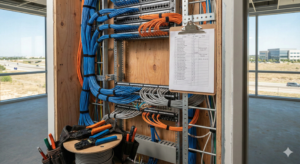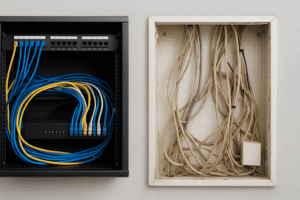Modern air conditioning systems are smarter, more efficient, and deliver better comfort than ever before. And much of this convenience is powered by low-voltage wiring. If you’ve ever peeked behind your thermostat or inside your AC control box, you’ve likely seen a nest of colored wires that are a little confusing at first. It might look complex, but with a little guidance, it all starts to make sense.
Why Low-Voltage Wiring Matters in AC Systems
Your central air conditioner runs on high-voltage power, but the communication between the thermostat, control board, and outdoor unit relies on low-voltage wiring, typically 24 volts. These wires send signals that control when to cool, fan, or switch modes. That’s why a correct AC low-voltage wiring diagram is essential for troubleshooting, upgrades, or new installations.
What Is an AC Low Voltage Wiring Diagram?
An AC low-voltage wiring diagram is a visual map showing how wires connect various AC components. It covers:
- Thermostat wiring terminals (Y, G, R, W, C, etc.)
- Air handler connections
- Outdoor condenser wiring
- Transformer output
- Safety switches or relays
This diagram ensures that each low-voltage wire is correctly assigned, helping homeowners and HVAC professionals install or service systems without confusion.
Common Symbols and Wire Colors
Crack the color code from the start. It is better to know what each wire really does. Most diagrams will feature basic color-coded lines, each representing a wire with a specific purpose:
- Red (R): Power from the transformer (24V)
- Yellow (Y): Cooling signal to the condenser
- Green (G): Fan/blower motor
- White (W): Heating (in combo systems)
- Blue or Black (C): Common wire (completes circuit)
Understanding these basics is a key part of reading a low-voltage wiring diagram for an air conditioner. Misplacing even one wire could mean your AC won’t turn on, or worse, short out. So it is better to know what to do beforehand.
Sample Diagram: Low Voltage Wiring for AC System
Behind every well-functioning AC unit is a clean, strategic layout of low-voltage wiring that brings all the magic into it. Below is a standard AC low-voltage wiring diagram that illustrates how a typical central air conditioner system is wired. This is the foundation used by most residential HVAC setups in North America.
This layout shows the thermostat at the top, the indoor air handler/furnace in the middle, and the outdoor condensing unit at the bottom. It also maps the flow of 24V signals and where each color-coded wire connects.
How to Use the Diagram
When dealing with thermostat issues, AC malfunctions, or installing a smart thermostat, this diagram is your blueprint. Here’s how to apply it:
- Label each wire before disconnecting anything.
- Match the wire colors to the terminals as shown in the diagram.
- Use a multimeter to confirm 24V power across the R and C wires.
- Check for continuity in the Y and G wires when the AC or fan is running.
Understanding a low-voltage wiring diagram for an air conditioner helps avoid guesswork and keeps your system safe.
Safety First
Although low-voltage wiring is less dangerous than high-voltage, safety precautions still apply:
- Turn off power at the HVAC breaker before touching any wires.
- Use insulated tools.
- Don’t assume wire color means wire function; verify everything.
When to Rewire or Upgrade
You might consider reworking your wiring if:
- Your thermostat is outdated or incompatible with smart features.
- You notice frequent short cycles or communication issues.
- Wires are brittle, exposed, or not secured properly.
An updated AC low-voltage wiring diagram can be a lifesaver in such cases, especially during DIY thermostat installations.
Final Thoughts
Your home’s comfort depends on more than just the AC’s power, the wiring behind the scenes matters just as much. Whether you’re upgrading your system, installing a new thermostat, or just learning how it all works, this AC low-voltage wiring diagram acts as your go-to reference.
By understanding this layout and the roles of each wire, you’re better equipped to maintain and troubleshoot your system confidently. And as HVAC technology evolves, this foundational knowledge remains timeless.





